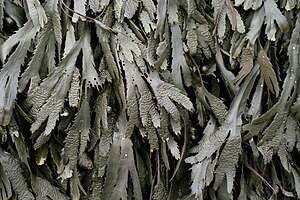Saw rod
| Saw rod | ||||||||||||
|---|---|---|---|---|---|---|---|---|---|---|---|---|

Sawwrack ( Fucus serratus ), with fruiting bodies |
||||||||||||
| Systematics | ||||||||||||
|
||||||||||||
| Scientific name | ||||||||||||
| Fucus serratus | ||||||||||||
| L. |
The sawwrack ( Fucus serratus ) is a type of brown algae that is also found in the North Sea and Baltic Sea.
description
The sawweed is a perennial large alga ( seaweed ) with a size of about 30 cm. At the base it is connected to the ground with an adhesive plate. The leathery, rough, brown-green thallus has a short stalk at the base, otherwise flattened, forked in one plane and traversed by a central rib. The edge of the thallus is sharply serrated, which is what the name refers to. It can be distinguished from bladder wrack due to the lack of gas bubbles, and from spiral wrack due to flat thallus ends . On the smooth, vegetative ends of the thallus, the sawwrack has colorless hair that emerges from pits and is recognizable as white dots.
Reproduction
Fucus species are diplomas without a generation change . From September to May, fruiting bodies ( receptacles ) are developed at the ends of the thallus . These are flat in the sawfish and therefore not as conspicuous as in the related species. The recipe sacs contain warty concept sacs sunk into the surface in the shape of a jug , in which the gametes are formed. The sawwrack is sexually separated, egg cells and sperm cells (swarmers) arise on different specimens ( diocyte ). With the rising tide, the germ cells emerge. After fertilization, the zygote settles and grows into a new diploid alga. In June and July the old fruiting bodies degenerate and young conceptacles are created at the ends of the thallus.
Occurrence
The sawwrack is widespread in the eastern North Atlantic from Spain to Spitzbergen and is also found in the North Sea and Baltic Sea . As an introduced species, it also grows on the North American Atlantic coast.
It inhabits the middle and lower intertidal zone down to the seaweed forest zone below the low water line. It prefers protected or less exposed areas and is found furthest down in the zoning of the Fucus species.
Systematics
The first description of Fucus serratus was made in 1753 by Carl Linnaeus in Species plantarum , Volume 2, p 1158. The Fucus serratus belongs to the genus Fucus in the family of Fucaceae within the order of Fucales .
Synonyms of Fucus serratus L. are Halidrys serrata (L.) Stackhouse and Virsodes serratum (L.) Kuntze.
use
In Ireland and France, seaweed is used to produce seaweed extracts for cosmetic products and seaweed baths ( thalassotherapy ).
swell
- Michael D. Guiry, GM Guiry: Fucus serratus. In: Algaebase - World-wide electronic publication, National University of Ireland, Galway , accessed March 21, 2012 (sections systematics, occurrences)
- Michael Guiry: The Seaweed Site: information on marine algae: Fucus serratus , accessed March 21, 2012 (sections description, usage)
- P. Kornmann, PH Sahling: Sea algae from Helgoland - Benthic green, brown and red algae. Biological Institute Helgoland, Hamburg 1983, ISSN 0017-9957 , pp. 162-167 (sections description, reproduction)
